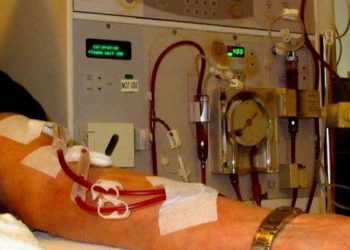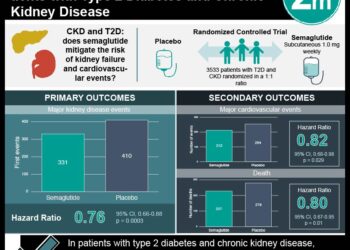Kidney failure risk equation (KFRE) discriminates risk in children with chronic kidney disease
1. The kidney failure risk equation (KFRE), currently used in adults to estimate risk for progression to end-stage renal disease (ESRD) based on demographic and laboratory data, also provides excellent discrimination of ESRD risk in a pediatric cohort with chronic kidney disease.
2. The performance of the KFRE in predicting risk for ESRD in children was similar by race and cause of CKD, but statistically different by ethnicity and age, with improved prediction in Hispanic and older (>12 years old) patients, respectively.
Evidence Rating Level: 2 (Good)
Study Rundown: The kidney failure risk equations (KFREs) is accurate for identifying adults at risk for progression to ESRD, and are currently used to determine timing for dialysis access and kidney transplant. Though previous studies have demonstrated applicability of the KFRE to Canadian, European, and African American cohorts, a similar study had not yet been done to evaluate accuracy of the KFRE in children. Results from this retrospective cohort study demonstrated that both the 4-variable equation (age, sex, eGFR, and ratio of albumin to creatinine levels [ACR]) and 8-variable equation (4-variables plus serum calcium, phosphate, bicarbonate, and albumin levels) provide excellent discrimination of ESRD risk in pediatric participants enrolled in the Chronic Kidney Disease in Children (CKiD) study. The study compared KFRE performance by various patient characteristics, and found no difference in performance based on race (white vs. nonwhite) and cause of CKD (glomerular vs. nonglomerular), but statistically significant differences based on ethnicity (Hispanic vs. non-Hispanic) and age (12+ years vs. >12 years of age).
Limitations of the study included reliance on estimation of albuminuria measurements from proteinuria measurements for a subset of patients, and limited data within subsets of race, ethnicity, and age. Therefore, further study of the influence of these characteristics on the predictive value of KFREs is warranted. Overall, the results of this study have implications for using KFRE to predict ESRD risk in order to improve the timing of anticipatory guidance, referrals of patients to nephrologists, improved completion of immunizations before transplant, and preemptive kidney transplant.
Click to read the study, published in JAMA Pediatrics
Relevant Reading: A predictive model for progression of chronic kidney disease to kidney failure
In-Depth [prospective cohort study]: This study applied the KFRE to a cohort of 603 pediatric participants enrolled in the Chronic Kidney Disease in Children (CKiD) study, who were between the ages of 1 and 16 years and included in the study once their eGFR fell below 60 mL/min/1.73 m2. Their ESRD risks were calculated based on KFRE using 4 variables (age, sex, eGFR, and ratio of albumin to creatinine levels [ACR]) and 8 variables (4 variables plus serum calcium, phosphate, bicarbonate, and albumin levels). Participants were followed prospectively to determine time to ESRD. Overall, both equations were found to provide excellent discrimination of risk, with C-statistics >0.80 for 1-, 2-, and 5-year risks, with a C-statistic of 0.91 for the 8-variable KFRE for 1-year KFRE risk. The performance of the KFRE was similar by race (white vs. nonwhite) and cause of CKD (glomerular vs. nonglomerular), but statistically different by ethnicity (higher in Hispanic vs. non-Hispanic participants, C-statistic difference 0.10; 0.04 to 0.16, 95% CI) and age (higher in participants younger than 12 years vs. 12 years and older, C-statistic difference 0.09; 0.03 to 0.15, 95% CI).
Image: PD
©2017 2 Minute Medicine, Inc. All rights reserved. No works may be reproduced without expressed written consent from 2 Minute Medicine, Inc. Inquire about licensing here. No article should be construed as medical advice and is not intended as such by the authors or by 2 Minute Medicine, Inc.






